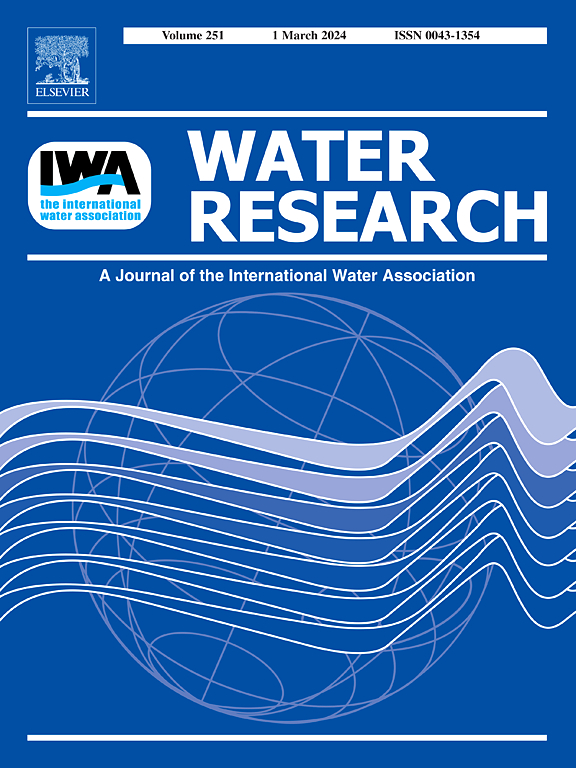降低细胞色素c:探讨其对假单胞菌JM-7和反硝化硫杆菌协同反硝化作用的促进作用
IF 12.4
1区 环境科学与生态学
Q1 ENGINEERING, ENVIRONMENTAL
引用次数: 0
摘要
硝酸盐在自然生态系统中的过度积累可导致水体富营养化,造成藻华和赤潮等环境影响,对环境和人类健康构成严重威胁。自养反硝化是一种资源高效的生物脱氮技术,但自养反硝化菌生长缓慢、电子传递效率低限制了其实际应用。本研究利用异养反硝化细菌Pseudomonas sp. JM-7 (P. JM-7)与自养反硝化硫杆菌thiobacillus反硝化硫杆菌ATCC 25259混合培养,形成异养-自养协同反硝化过程(mixPT),增强电子传递,提高反硝化效率。结果表明,在初始硝酸盐浓度为430 mg/L的条件下,P. JM-7以1 g/L酵母浸膏粉(YEP)为电子供体,在90 h内还原了约210 mg/L的硝酸盐(48.8%),而反硝化硫杆菌几乎没有去除硝酸盐。相比之下,mixPT体系减少了约360 mg/L的硝酸盐(83.3%),几乎是单独使用P. JM-7的1.7倍。mixPT培养物在低碳水体(10 mg/L)中也表现出良好的反硝化效果,在120 h内完全去除了40 mg/L的硝酸盐。假单胞菌JM-7产生的细胞色素c是反硝化硫杆菌反硝化的优良电子传递介质,在异养-自养联合反硝化过程中发挥了关键作用。假单胞菌sp. JM-7的吸附作用缩短了自养反硝化细菌与细胞色素c的接触距离,使细胞色素c易于将电子直接转移给自养细菌,从而减少了转移过程中电子的损失,提高了电子的利用效率。这些结果证明了mixPT系统在控制富营养化水体中的潜在应用,并提出假单胞菌JM-7的细胞色素c可以作为一种新型的高质量电子传递介质。此外,本研究克服了异养反硝化细菌Pseudomonas sp. JM-7在低碳环境中反硝化效率低的限制,扩大了Pseudomonas sp. JM-7在低碳环境中的利用。本文章由计算机程序翻译,如有差异,请以英文原文为准。

Reduced Cytochrome c: Exploring Its Promoting Function in Synergistic Denitrification by Pseudomonas sp. JM-7 and Thiobacillus denitrificans
Excessive accumulation of nitrate in natural ecosystems can lead to eutrophication of water bodies, resulting in environmental impacts such as algal blooms and red tides that pose serious threats to environmental and human health. Autotrophic denitrification is a resource-efficient biological nitrogen removal technology, but the slow growth and low electron transfer efficiency of autotrophic denitrifiers limit their practical application. In this study, the heterotrophic denitrifying bacterium Pseudomonas sp. JM-7 (P. JM-7) was used in mixed culture with the autotrophic denitrifying Thiobacillus denitrificans ATCC 25259 to form a heterotrophic-autotrophic synergistic denitrification process (mixPT) to enhance electron transfer and improve the denitrification efficiency. Our results for an initial nitrate concentration of 430 mg/L showed that P. JM-7 reduced approximately 210 mg/L nitrate (48.8 %) in 90 h, with 1 g/L yeast extract powder (YEP) as the electron donor, while Thiobacillus denitrificans barely removed nitrate. In contrast, the mixPT system reduced approximately 360 mg/L nitrate (83.3 %), nearly 1.7 times greater than P. JM-7 alone. The mixPT culture also exhibited excellent denitrification in low carbon waters (10 mg/L), and removed 40 mg/L nitrate completely within 120 h. Cytochrome c produced by Pseudomonas sp. JM-7, which is an excellent electron transfer mediator for denitrification by Thiobacillus denitrificans, played a crucial role in the heterotrophic-autotrophic syntrophic denitrification. The adsorption effect of Pseudomonas sp. JM-7 shortened the contact distance between the autotrophic denitrifying bacteria and cytochrome c, which made it easy for cytochrome c to transfer the electrons to the autotrophic bacteria directly, thereby reducing the loss of electrons in the process of transfer, and improved the electron utilization efficiency. These findings have demonstrated the potential applications of mixPT system in controlling eutrophic waters and propose cytochrome c of Pseudomonas sp. JM-7 could serve as a novel and high-quality electron transfer mediator. Furthermore, this study have overcome the restriction of low denitrification efficiency exhibited by heterotrophic denitrifying bacteria Pseudomonas sp. JM-7 in low-carbon environments and expanded the utilisation of Pseudomonas sp. JM-7 in low carbon environments.
求助全文
通过发布文献求助,成功后即可免费获取论文全文。
去求助
来源期刊

Water Research
环境科学-工程:环境
CiteScore
20.80
自引率
9.40%
发文量
1307
审稿时长
38 days
期刊介绍:
Water Research, along with its open access companion journal Water Research X, serves as a platform for publishing original research papers covering various aspects of the science and technology related to the anthropogenic water cycle, water quality, and its management worldwide. The audience targeted by the journal comprises biologists, chemical engineers, chemists, civil engineers, environmental engineers, limnologists, and microbiologists. The scope of the journal include:
•Treatment processes for water and wastewaters (municipal, agricultural, industrial, and on-site treatment), including resource recovery and residuals management;
•Urban hydrology including sewer systems, stormwater management, and green infrastructure;
•Drinking water treatment and distribution;
•Potable and non-potable water reuse;
•Sanitation, public health, and risk assessment;
•Anaerobic digestion, solid and hazardous waste management, including source characterization and the effects and control of leachates and gaseous emissions;
•Contaminants (chemical, microbial, anthropogenic particles such as nanoparticles or microplastics) and related water quality sensing, monitoring, fate, and assessment;
•Anthropogenic impacts on inland, tidal, coastal and urban waters, focusing on surface and ground waters, and point and non-point sources of pollution;
•Environmental restoration, linked to surface water, groundwater and groundwater remediation;
•Analysis of the interfaces between sediments and water, and between water and atmosphere, focusing specifically on anthropogenic impacts;
•Mathematical modelling, systems analysis, machine learning, and beneficial use of big data related to the anthropogenic water cycle;
•Socio-economic, policy, and regulations studies.
 求助内容:
求助内容: 应助结果提醒方式:
应助结果提醒方式:


